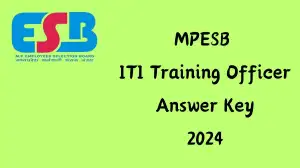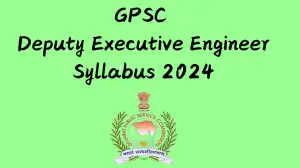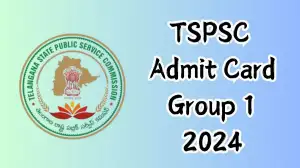APPSC Group 2 Mains Syllabus 2024 Check the Exam Pattern and Full PDF Here
by V Gomala | Updated May 17, 2024
APPSC Group 2 Vacancies
The APPSC is looking for candidates to fill executive and non-executive positions in Group 2. Candidates will be chosen based on their performance in the preliminary exam, the main exam, and a computer proficiency test. The main exam has two papers, Paper I and Paper II, both at the level of a college degree, with a total of 300 marks. Candidates can check the APPSC Group 2 Mains Syllabus 2024 PDF from the link below to identify relevant and irrelevant topics and plan their preparation accordingly.
APPSC Group 2 Mains Syllabus 2024
Paper I
Social History of Andhra Pradesh (Section A)
1. Pre - Historic Cultures - The Satavahanas, The Ikshvakus: Socio - Economic and Religious Conditions, Literature, Art and Architecture - The Vishnukundins, The Eastern Chalukyas of Vengi, Andhra Cholas: Society, Religion, Telugu Language, Art and Architecture.
2. Various Major and minor dynasties that ruled Andhradesa between11th and 16th centuries A.D. - Socio - Religious and Economic Conditions, Growth of Telugu Language and Literature, Art and Architecture in Andhradesa between 11th to 16th centuries A.D.
3. Advent of Europeans - Trade centers - Andhra under the Company - 1857 Revolt and its Impact on Andhra - Establishment of British Rule - Socio - Cultural Awakening, Justice Party/Self Respect Movement - Growth of Nationalist Movement in Andhra between 1885 to 1947 – Role of Socialists - Communists - Anti-Zamindari and Kisan Movements - Growth of Nationalist Poetry, Revolutionary Literature, Nataka Samasthalu and Women Participation.
4. Origin and Growth of Andhra Movement - Role of Andhra Mahasabhas - Prominent Leaders - Events leading to the formation of Andhra State 1953 - Role of Press and News Papers in the Andhra Movement - Role of Library Movement and Folk and Tribal Culture.
5. Events leading to the Formation of Andhra Pradesh State - Visalandhra Mahasabha - States Reorganization Commission and its Recommendations - Gentlemen Agreement - Important Social and Cultural Events between 1956 to 2014.
Indian Constitution (Section B)
6. Nature of Indian Constitution - Constitutional Development - Salient features of Indian Constitution - Preamble - Fundamental Rights, Directive Principles of State Policy and their relationship - Fundamental Duties - Amendment of the Constitution- Basic Structure of the Constitution.
7. Structure and Functions of Indian Government - Legislative, Executive and Judiciary - Types of Legislatures: Unicameral, Bicameral - Executive - Parliamentary - Judiciary - Judicial review - Judicial Activism.
8. Distribution of Legislative and Executive Powers between the Union and the States; Legislative, Administrative and Financial Relations between the Union and the States - Powers and Functions of Constitutional Bodies - Human Rights Commission - RTI - Lokpal and Lok Ayukta.
9. Center-State Relations - Need for Reforms - Rajmannar Committee, Sarkaria Commission, M.M.Punchchi Commission - Unitary and Federal features of Indian Constitution - Indian Political Parties - Party System in India - Recognition of National and State Parties - Elections and Electoral Reforms - Anti-Defection Law.
10. Centralization Vs Decentralization - Community Development Programme - Balwant Rai Mehta, Ashok Mehta Committees - 73rd and 74th Constitutional Amendment Acts and their Implementation
Paper II
Indian and AP Economy (Section A)
Structure of Indian Economy, Economic Planning and Policy: National Income of India: Concept and Measurement of National Income - Occupational Pattern and Sectoral Distribution of Income in India – Economic Growth and Economic Development, etc
Money, Banking, Public Finance and Foreign Trade: Functions and Measures of Money Supply – Reserve Bank of India(RBI): Functions, Monetary Policy and Control of Credit – Indian Banking: Structure, Development and Reforms – Inflation, etc.
Agricultural Sector, Industrial Sector and Services in Indian Economy: Indian Agriculture: Cropping Pattern, Agricultural Production and Productivity – Agricultural
Finance and Marketing in India: Issues and Initiatives – Agricultural Pricing and Policy in India: MSP, Procurement, Issue Price and Distribution – Industrial Development in India: Patterns and Problems – New Industrial Policy, 1991 – Disinvestment, etc.
Structure of Andhra Pradesh Economy and Public Finance: Structure and Growth of AP Economy: Gross State Domestic Product (GSDP) and Sectoral Contribution, AP Per Capita Income (PCI) – AP State Revenue, etc.
Agriculture and Allied Sector, Industrial Sector and Services Sector of Andhra Pradesh: Production Trends of Agriculture and Allied Sectors – Cropping Pattern –Rural Credit Cooperatives – Agricultural Marketing – Strategies, Schemes and Programmes related to Agricultural Sector and Allied Sectors in Andhra Pradesh, etc
Science and Technology (Section B)
Technology Missions, Policies and Applications: National S&T Policy: Recent Science, Technology and Innovation Policy, and National Strategies and Missions, Emerging Technology Frontiers – Space Technology: Launch Vehicles of India, etc.
Energy Management: Policy and Projections: Installed Energy Capacities and Demand in India - National Energy Policy - National Policy on Biofuels - Bharat Stage Norms - Non-Renewable and Renewable Energy, etc.
Ecosystem and Biodiversity: Ecology and Ecosystem: Basic concepts of Ecology, Ecosystem: Components and Types – Biodiversity: Meaning, Components, Biodiversity Hotspots, Loss of Biodiversity and Conservation of Biodiversity, etc.
Waste Management and Pollution Control: Solid Waste: Solid Wastes and their Classification – Methods of Disposal and Management of Solid Wastes in India – Environmental Pollution: Types of Environmental Pollution – Sources and Impacts, etc.
Environment and Health: Environment Challenges: Global Warming, Climate Change, Acid Rain, Ozone Layer Depletion, Ocean Acidification – Environmental Initiatives: Recent International Initiatives, Protocols, Conventions to tackle Climate Change with special reference to India’s Participation, etc.
Exam Pattern
Aspirants planning to appear in the recruitment must check the APPSC Group 2 Mains exam pattern to understand the question structure, maximum marks, number of questions, and marking scheme as specified in the official notification. Those who pass the main exam will be called to take the computer proficiency test. Here is an overview of the APPSC Group 2 Mains exam pattern:
Paper |
Subject |
No. Of Questions |
Marks |
|
Paper I |
Social History of Andhra Pradesh i.e., the history of Social and Cultural Movements in Andhra Pradesh. General overview of the Indian Constitution |
150 |
150 |
|
Paper II |
Indian and AP Economy,Science and Technology |
150 |
150 |
|
Total |
300 |
300 |
|
Download the PDF
Here is the full PDF
Tips to Crack the APPSC Group 2 Mains Exam
The APPSC Group 2 Mains exam tests candidates on four areas: the Social History of Andhra Pradesh, a general overview of the Indian Constitution, the Indian and Andhra Pradesh Economy, and Science and Technology. Here are some expert tips to help you succeed:
- Review the APPSC Group 2 Mains exam syllabus for 2024 to understand the importance of each section and its sub-topics.
- Use high-quality textbooks and reference materials to gain a clear understanding of all the basic and advanced topics.
- Practice mock tests and previous years' papers to get a feel for the exam and develop your answering strategy.
- Regularly revise all important topics to achieve high marks in the mains exam.



